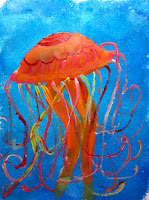I've made an interesting observation within my last few kid's art workshops; an age range in class is beneficial to the creative process.
Now, I haven't done any scientific, psychological studies or anything, but I do spend a lot of time with children and their art. It seems that around third or fourth grade children start to fear creativity. They begin to feel anxious about being right versus wrong (understandably in our test-crazy educational system.) Some have a hard time with the whole trying and not caring if it's perfect. It is almost as if they have begun to define themselves as artistic or not-artistic.
Kindergartners are fun to watch doing art. They are boundless with their creations, happy to mix a paint color and never actually apply it to a canvas. Exploring and trying to do something as simple as drawing a star can give them immeasurable pleasure, and upon their success the gratification is the joy of being able to guide their mind and their hand together.
A parent asked if I was going to start splitting up my classes by age. I respect that question and certainly someone in upper middle school and in high school might have a hard time in the same class as a first grader that doesn't comprehend in-depth instruction. But, after I thought about it I figured that first graders in the same art classes as seventh graders could actually benefit both parties.
The free-flowing creativity of younger students and the detail orientation and calm of older students are a great combination in an art classroom. The energy rises and falls and ultimately, they inspire each other.
























































